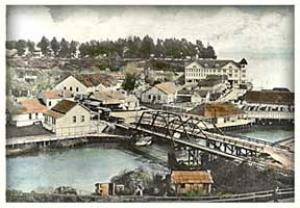Capitola History
Capitola is built on the location of an Indian village that existed for more than a thousand years. The Native inhabitants were removed to the Mission Santa Cruz when it was established in 1791. Nearly all traces of the Soquel “rancheria” and its culture vanished. In the Mexican Era that followed, the territory became part of the Soquel Rancho granted to Martina Castro and husband Michael Lodge in 1833.
California became a state in 1850 and Santa Cruz County was formed in 1850, shortly before German immigrant Frederick Hihn—a pioneer credited with developing much of the county’s early industry—acquired the site of present-day Capitola Village and environs from the Castro family.
As settlers engaged in logging and agriculture, the beach became a busy shipping point known as Soquel Landing. A wharf built in 1857 was expanded to 1,200 feet a few years later. Gradually, a small fishing colony of Italian immigrants settled at its base.
Drawn by cool mists and the smooth beach at the mouth of Soquel Creek, travelers stopped and often stayed as long as they were permitted. Increasingly, vacationers thirsting for a break from hot weather in the Santa Clara Valley found the seashore inviting for an overnight camp. After roads over the Summit were built and improved in the mid-1860s, word about the sanctuary reached further into the state’s interior to places like Hollister, Fresno, Modesto, and Stockton—towns that would in a few years lend their names to the streets of Capitola.
Hihn leased the beach flat to Soquel pioneer Samuel A. Hall in 1869. Hall saw that the landscape that provided refuge from the summer heat could also be profitable. His foresight created the place known now as the oldest seaside resort on the Pacific Coast.
“Camp Capitola” opened in June, 1874. It is thought that Hall’s daughter, Lulu, christened Capitola for the heroine featured in popular novels by E.D.E.N. Southworth. The camp’s success was guaranteed by passenger service on the Santa Cruz-Watsonville Railroad, completed in 1876.
Once Capitola prospered, Hihn took over direct control of the enterprise, and subdivided lots for sale beginning in 1882. Over time, the old camping spot grew into “Capitola by the Sea,” a vacation spa with a 160-room hotel, hot saltwater baths, and electric streetcar service from Santa Cruz.
Hihn died in 1913, but his daughter waited until after World War I to sell off the Capitola portion of his estate. Henry Allen Rispin, a speculator from San Francisco, bought Capitola in 1919 with plans to build an updated, fashionable haven. Among his ventures were a reconfiguration of the Esplanade, construction of the Venetian Courts, and development of a golf course.
Overextended and losing his estate to foreclosures by 1927, Rispin left Capitola after the start of the Great Depression of 1929, and never returned.
Capitola’s community of permanent residents stepped forward to guide Capitola in the following decades. The village became the third city in Santa Cruz County after an incorporation election in January 1949.

